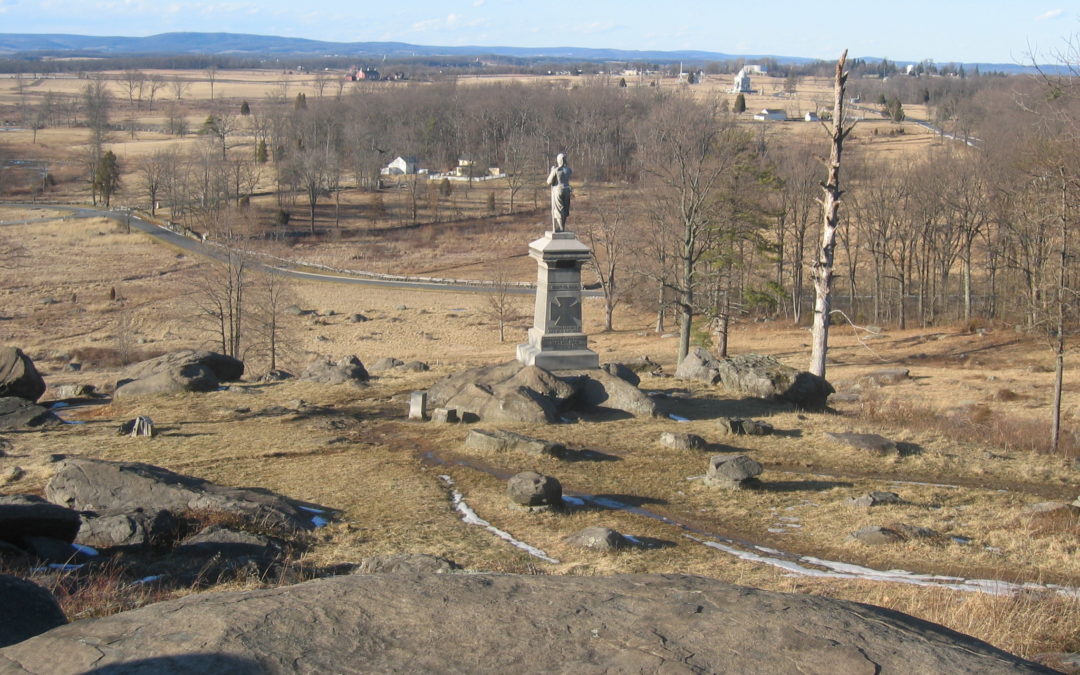George Pressly McClelland was serving as a sergeant in the 155th Pennsylvania Infantry when his unit, a part of the Army of the Potomac, was sent from Fredericksburg, Virginia to intercept the Army of Northern Virginia, thought to be passing through Maryland on their way north. Was the Confederate Army in the throes of planning an attack on Washington City? Union leadership had an uneasy sense that Robert E. Lee was preparing for a bold move – to strike at the Union capital.
Sergeant McClelland and the men of the Fifth Corps, Army of the Potomac, were exhausted by their long march from Virginia in the late June heat when they reached a location twelve miles from Gettysburg. Pennsylvania. Hungry, foot-sore, and weary, the infantry was only somewhat heartened by the fact that they were, at last, going to face their enemy on Yankee ground. The commanding general of the Army of the Potomac, George Meade, pronounced: “The enemy is on our soil. The whole country looks anxiously to this army to deliver it from the presence of the foe.”
In the afternoon of July 2, 1863, Brigadier General Gouvereur Warren, Meade’s chief engineer, rode to the top of the Union signal station on Little Round Top to observe the battle taking place below the summit of this high ground. Warren’s analysis of the events unfolding in the nearby wheat field, peach orchard, and Devil’s Den was interrupted when a glint beyond the Union left caught his eye. It was John Bell Hood’s Confederate division making its way along the nearby wooded hillside, clearly taking a position to flank the Union line.
While a staff officer commanding no fighting units of his own, Warren recognized the gravity of the unfolding situation and that quick, decisive action was required. First, he took steps to bring a brigade under Colonel Strong Vincent to move up from the base of the hill and occupy the top of Little Round Top. Seeing that the four regiments of that brigade would not suffice, Warren pleaded with Fifth Corps commander, Major General George Sykes, to release his third brigade, led by Brigadier General Stephen Weed, to reinforce Vincent’s troops.
Now eight Union regiments, including Sergeant George McClelland in the 155th Pennsylvania, shored up the vulnerable Union left. These eight regiments – with the 20th Maine on the left and the 155th Pennsylvania on the right – stretched across Little Round Top in a seamless barrier of resistance. Fighting on Little Round Top raged the rest of July 2 until dark when, despite waves of Confederate attackers, the Union line held and Hood’s forces withdrew. These Confederate units suffered heavy casualties, yet the Union had light losses. However, some of the Union’s most promising leaders were killed at Little Round Top: Colonels Strong Vincent and Patrick O’Rorke, and Brigadier General Stephen Weed were mortally wounded during the fighting.
The next day, July 3, Union troops awoke, not to the sound of reveille, but Union officers circulating among the ranks to wake their men. Silence was to be observed in the expectation of a resumption of a Confederate assault. An infantry assault never occurred. Rather, at about 1 p.m., Confederate artillery pounded the Union line for an hour. Union artillery returned the fire. Then, after the dueling artilleries fell silent, Lee’s men began forming out of the woods at Seminary Ridge. Units under Pickett, Pettigrew, and Trimble advanced over the open field toward Union forces on Cemetery Ridge. This assault — known thereafter as “Pickett’s Charge” – could be clearly seen by many of the Union men on Little Round Top. Sergeant McClelland had an unobstructed view of the Confederate forces making their fateful charge on that hot afternoon of July 3rd. Nearly two-thirds of Lee’s men who charged the Union line on that field of fire were casualties.
McClelland, who had been fighting less than 24 hours earlier, was now able to be an observer of one of the most infamous infantry charges in military history. A distraught Confederate General James Longstreet later wrote: “That day at Gettysburg was one of the saddest of my life.”
Thanks to the Park Service initiative to clear 354 acres of post-battle woodland in the 1990’s, Gettysburg visitors can now stand at the 155th Regiment monument on Little Round Top and see the same unobstructed view of the ground that Sergeant McClelland saw where Pickett’s Charge occurred on the afternoon of July 3, 1863.
Photograph taken on Little Round Top showing the location of the 155th Pennsylvania Regiment monument overlooking the Gettysburg battlefield.
Text based on Your Brother in Arms: A Union Soldier’s Odyssey, by Robert C. Plumb, University of Missouri Press, 2011.


Recent Comments